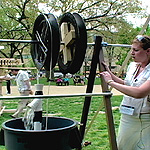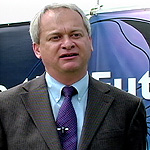2007年VOA标准英语-Students' Designs Provide Look into Future(在线收听)
Washington, D.C.
26 April 2007
At the base of the U.S. Capitol in Washington D.C., 41 teams of college students are competing in the National Sustainable Design Expo. Some of their environmentally friendly and sustainable projects could turn out to be the wave of the future. Producer Zulima Palacio checked out some of the projects and prepared this report. Jim Bertel narrates the story.
From a "Mechanical Aerator" that oxygenates shrimp hatcheries and keeps more shrimp alive, to the use of algae for the production of biodiesel, these are just two examples of the college students' creativity to solve problems.
"This is our camel wheel,” explains Kim Morris from the University of New Hampshire, “so the camel walks in circles -- he's going to be our camel -- so as the camel walks in circles, it pumps water out of the well, using the rope-and-washer pump design."
 |
| Kim Morris explains her team's low technology water pump prototype |
"This is a system set up in Africa. It is set up to kind of funnel the water that you see coming out of this pipe directly into the cistern," she says.
And from the cistern the water goes into an irrigation system already in place in Nigeria, where the real project is installed.
The 41 teams of students are trying to win one of the six $75,000 awards for the commercial development of their projects. The U.S. Environmental Protection Agency (EPA) is helping to sponsor the competition. Chris Zarba is the deputy director for the National Center for Environmental research within the EPA.
 |
| Chris Zarba, Environmental Protection Agency |
"Right now I am producing about three amps,” says Michael Eggleston, “which then goes to a 12 volt DC battery -- that is about 36 watts and that's enough to power about two of these [laptop computers]."
At the "Calories to Kilowatts" project Eggleston and his team from Albion College in the Midwest state of Michigan plan to create an energy education workout center in Cambodia, where students can convert human energy into electricity. Once they have enough energy stored they can use it in their living spaces and to study at night.
And for this team of student engineers from Rochester Institute of Technology in New York State, the issue is clean water. Nathan LaCroix explains their solar pasteurizer for treating water in rural areas.
"The whole idea is we dump water on the top bucket in the morning and throughout the day, the sun will heat the pasteurizer, it will heat it up and empty it into the lower bucket."
The water pasteurizer was initially designed for Venezuela. But now team members say it can work almost anywhere, producing more than 20 liters of clean water a day with these buckets.
The National Sustainable Design Expo plans to open its doors to international students within the next two or three years. But for the American college students who participated in this year's expo, they are already in the forefront of cutting-edge technologies for a sustainable future.